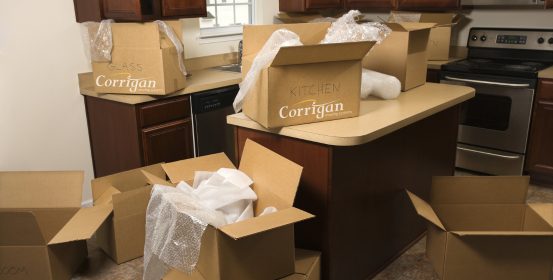
Organizing your move is the key to moving successfully, and proper labeling is the key to organization.
Not only is it important that your items are packed properly (using the right kind and amount of packing materials and placing them in the correct type of box), but it’s equally important that you label items with consideration, so your packing and unpacking is less stressful.
Here are five things to keep in mind:
If you haven’t done a walk-through of your new home with your realtor or landlord, now is the time to do so.
If possible, get a floor plan of your home from your realtor or leasing agent before you begin packing your items. Using the common-sense approach below, write acronyms on your floor plan and review it with your movers and family so everyone is clear where things are to be placed.
Easy-to-remember acronyms (MBR for ‘Master Bedroom,’ for example) will make it easy to place your boxes in the correct layout in your new home. Pick something that makes sense to you.
If you have multiple bedrooms, for instance, use simple terminology, such as ‘Bedroom 1′ and ‘Bedroom 2′ rather than, for instance, ‘Jason’s room’ or ‘Den’. Even though you may have an idea where you want your boxes placed, that doesn’t mean your movers have a clue how you plan on living in your new home.
If there are any doubts, before your movers begin placing boxes and furniture in your new home, walk through with the supervisor (and crew) and tell them exactly which room is which. A move is exhausting enough, and you don’t want to have to move boxes (or worse, furniture) yourself from one room to another after your moving crew has gone home.
A great way to label rooms is to use a large yellow Post-in Note securely fastened to the door frame of each room. Make sure it’s visible, and the acronym you’ve chosen to identify the room is written in black ink IN CAPITAL LETTERS with a Sharpie.
Clear labels will speed up the move-in process and lead to less work after movers place your boxes and furniture in your desired location.
The first thing you must keep in mind as you plan your move is to use the correct type of box (clean, sturdy, preferably new) for your items. Avoid boxes that once contained chemicals, food, or other things with an odor.
A move isn’t the time to scrimp on materials, so make sure you select them carefully. Home Depot, Office Depot, and Walmart are great places to get a variety of box sizes at a reasonable price. You can also check with your moving company.
When labeling, use large, white labels on which you can explicitly write the destination room. It’s more important to label the box’s destination in your new home rather than its contents, but if you do write the contents of your boxes on the outside, be sure you also write the destination room using the naming scheme outlined in Step 2 above.
It’s just as important to label furniture as the boxes. You don’t want to have to move furniture yourself after the movers have gone, so make sure you securely fasten labels to furniture.
To avoid marks and adhesive on your furniture, use easy-to-remove stickers or blue painter’s tape. Avoid using duct tape on furniture as it can cause damage. Make sure to write in LARGE CAPITAL LETTERS to minimize confusion.
You want to make the mover’s job as simple and straightforward as possible, whether they’re a company you’ve hired or friends you’ve asked to help.
That’s it! Label correctly, and your move will be less stressful for everyone concerned.